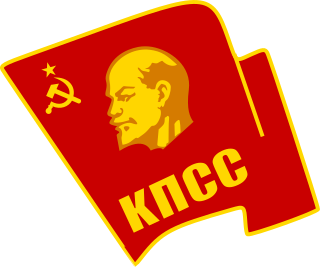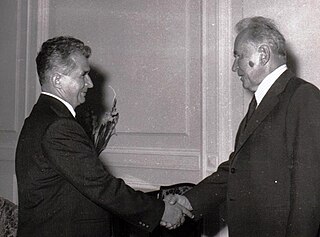Related Research Articles

The Communist Party of the Soviet Union (CPSU), also known by various other names during its history, was the founding and ruling party of the Soviet Union. The CPSU was the sole governing party of the Soviet Union until 1990 when the Congress of People's Deputies modified Article 6 of the 1977 Soviet Constitution, which had previously granted the CPSU a monopoly over the political system. The party has its roots in the Russian Social Democratic Labour Party (RSDLP). The RSDLP was founded in 1898, when Russia was ruled by an absolute monarchy. The broad anti-Tsarist ideology was the driving factor in its initial growth. Russians across the political spectrum flocked to the party, as Marxists, socialists, and centrists made up its ranks. Despite the Tsar's harsh oppression including imprisoning and even executing party members, the RSDLP continued to grow, albeit underground. Initially the party operated in a unified and cohesive manner, but by 1900 cracks within party unity began to show.

Perestroika was a political movement for reform within the Communist Party of the Soviet Union (CPSU) during the late 1980s widely associated with CPSU general secretary Mikhail Gorbachev and his glasnost policy reform. The literal meaning of perestroika is "reconstruction", referring to the restructuring of the Soviet political and economic system, in an attempt to end the Era of Stagnation.

The Supreme Soviet of the Union of Soviet Socialist Republics was, beginning in 1936, the most authoritative legislative body of the Union of Soviet Socialist Republics (USSR), and the only one with the power to approve constitutional amendments. Prior to 1936, the Congress of Soviets was the supreme legislative body. During 1989–1991 a similar, but not identical structure was the supreme legislative body. The Supreme Soviet elected the USSR's collective head of state, the Presidium; and appointed the Council of Ministers, the Supreme Court, and the Procurator General of the USSR.

Nikolai Viktorovich Podgorny was a Soviet statesman who served as the Chairman of the Presidium of the Supreme Soviet, the head of state of the Soviet Union, from 1965 to 1977.

Nikolai Ivanovich Ryzhkov is a Soviet, and later Russian, politician. He served as the last Chairman of the Council of Ministers. Responsible for the cultural and economic administration of the Soviet Union during the Gorbachev Era, Ryzhkov was succeeded as premier by Valentin Pavlov in 1991. The same year, he lost his seat on the Presidential Council, going on to become Boris Yeltsin's leading opponent in the Russian Soviet Federative Socialist Republic (RSFSR) 1991 presidential election.

The Presidium of the Supreme Soviet was a body of state power in the Union of Soviet Socialist Republics (USSR). The presidium was elected by joint session of both houses of the Supreme Soviet to act on its behalf while the Supreme Soviet was not in session. By the 1936 and 1977 Soviet Constitution, the Presidium of the Supreme Soviet served as the collective head of state of the USSR. In all its activities, the Presidium was accountable to the Supreme Soviet of the USSR.

Gennady Ivanovich Yanayev was a Soviet politician who served as the first and only vice president of the Soviet Union. Yanayev's political career spanned the rules of Khrushchev, Brezhnev, Andropov and Chernenko, and culminated during the Gorbachev years. Yanayev was born in Perevoz, Gorky Oblast. After years in local politics, he rose to prominence as Chairman of the All-Union Central Council of Trade Unions, but he also held other lesser posts such as deputy of the Union of Soviet Societies for Friendship and Cultural Relations with Foreign Countries.

Demokratizatsiya was a slogan introduced by Soviet Communist Party General Secretary Mikhail Gorbachev in January 1987 calling for the infusion of "democratic" elements into the Soviet Union's single-party government. Gorbachev's Demokratizatsiya meant the introduction of multi-candidate—though not multiparty—elections for local Communist Party (CPSU) officials and Soviets. In this way, he hoped to rejuvenate the party with progressive personnel who would carry out his institutional and policy reforms. The CPSU would retain sole custody of the ballot box.

The Ministries of the Soviet Union were the government ministries of the Soviet Union.
The Central Control Commission was a supreme disciplinary body of the Communist Party of the Soviet Union. Its members were elected at plenary sessions of the Central Committee.

The Pridnestrovian Moldavian Soviet Socialist Republic (PMSSR), also commonly known as Soviet Transnistria or simply known as Transnistria, was created on the eastern periphery of the Moldavian Soviet Socialist Republic (MSSR) in 1990 by pro-Soviet separatists who hoped to remain within the Soviet Union when it became clear that the MSSR would achieve independence from the USSR and possibly unite with Romania. The PMSSR was never recognised as a Soviet republic by the authorities in either Moscow or Chișinău. In 1991, the Pridnestrovian Moldavian Republic succeeded the Pridnestrovian Moldavian Soviet Socialist Republic.

The 23rd Congress of the Communist Party of the Soviet Union (CPSU) took place in Moscow, RSFSR between 29 March and 8 April 1966. It was the first Congress during Leonid Brezhnev's leadership of the Party and state. The position of First Secretary was renamed back to General Secretary, which had been its name from 1922 to 1952. The congress elected the 23rd Central Committee.
The People's Commissariat of the Workers' and Peasants' Inspection, also known as Rabkrin, was a governmental establishment in the Soviet Union of ministerial level that was responsible for scrutinizing the state, local and enterprise administrations.
The Government of the Soviet Union, formally the All-Union Government of the Union of Soviet Socialist Republics, commonly abbreviated to Soviet Government, was the executive and administrative organ of state in the former Soviet Union. It had four different names throughout its existence; Council of People's Commissars (1923–1946), Council of Ministers (1946–1991), Cabinet of Ministers and Committee on the Operational Management of the National Economy. It also was known as Workers-Peasants Government of the Soviet Union.

The Presidium of the 22nd Congress of the Communist Party of the Soviet Union (CPSU) was in session from 1961 to 1966. CPSU First Secretary Nikita Khrushchev chaired the Presidium from 1961 to 1964; Leonid Brezhnev succeeded him that year and chaired it until 1966. In contrast to full members, candidate members of the Presidium could not vote during Presidium sessions. It was normal that a full member of the Presidium had previously served as a candidate member, but this was not always the case. During the term 23 people held seats in the Presidium: 14 full members and 9 candidate members. One candidate member was promoted to full membership in the Presidium during the term. Not a single Presidium member died during this period while retaining office.

The 1973 Soviet economic reform was an economic reform initiated by Alexei Kosygin, the Chairman of the Council of Ministers. During Leonid Brezhnev's rule of the Union of Soviet Socialist Republics (USSR), the Soviet economy began to stagnate; this period is referred to by some historians as the Era of Stagnation. After the failed 1965 reform Kosygin initiated another reform in 1973 to enhance the powers and functions of the regional planners by establishing associations. The reform was never fully implemented, and members of the Soviet leadership complained that the reform had not even been fully implemented by the time of the 1979 reform.

The Council of Ministers of the Union of Soviet Socialist Republics, was the de jure government of the Union of Soviet Socialist Republics (USSR), comprising the main executive and administrative agency of the USSR from 1946 until 1991.

The economy of the Soviet Union was based on state ownership of the means of production, collective farming, and industrial manufacturing. An administrative-command system managed a distinctive form of central planning. The Soviet economy was characterized by state control of investment, a dependence on natural resources, shortages of many consumer goods, little foreign trade, public ownership of industrial assets, macroeconomic stability, negligible unemployment and high job security.
References
- Adams, Jan S. (1978). "Institutional Change in the 1970s: The Case of the USSR People's Control Committee." Slavic Review 37(3):457 - 472.
- Adams, Jan S. (1989). "USSR People's Control Committee and Perestroika." Radio Liberty Report on the USSR 1(4):1 - 3.
![]() This article incorporates text from this source, which is in the public domain . Country Studies. Federal Research Division.
This article incorporates text from this source, which is in the public domain . Country Studies. Federal Research Division.